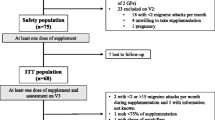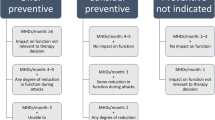Abstract
Despite the huge health and economic burden of migraine headache, few medications have been approved for its prophylactic treatment, most of which can potentially induce serious adverse effects. Coenzyme Q10 (CoQ10) is a supplement and has shown preliminary benefits in migraine prophylaxis. We aimed to assess this effect in an adult population. This is an open-label, parallel, add-on, match-controlled trial. Eighty patients diagnosed with migraine headache based on International Headache Society criteria were allocated to receiving only their current preventive drugs or their current preventive drugs plus 100 mg CoQ10 daily, matching for their baseline characteristics, and were assessed for frequency and severity of attacks, and ≥50 % reduction in attack frequency per month. Thirty-six and 37 patients were analyzed in CoQ10 and control groups, respectively. Number of attacks per month dropped significantly in the CoQ10 group (mean decrease: 1.6 vs. 0.5 among CoQ10 and control groups, respectively, p < 0.001). A significant reduction was also evident in the severity of headaches (mean decrease: 2.3 vs. 0.6 among CoQ10 and control groups, respectively, p < 0.001). For ≥50 % reduction in the frequency of attacks per month, the number needed to treat was calculated as 1.6. No side effects for CoQ10 were observed. This study suggests that CoQ10 might reduce the frequency of headaches, and may also make them shorter in duration, and less severe, with a favorable safety profile.



Similar content being viewed by others
References
Vos T, Flaxman AD, Naghavi M et al (2012) Years lived with disability (YLD) for 1160 sequelae of 289 diseases and injuries 1990–2010: a systematic analysis for the Global Burden of Disease Study 2010. Lancet 380:2163–2196
Hershey A, Powers S, Vockell A, LeCates S, Ellinor P, Segers A et al (2007) Coenzyme Q10 deficiency and response to supplementation in pediatric and adolescent migraine. Headache 47(1):73–80
Rozen T, Oshinsky M, Gebeline C, Bradley K, Young W, Shechter A et al (2002) Open label trial of coenzyme Q10 as a migraine preventive. Cephalalgia 22(2):137–141
Sándor PS, Di Clemente L, Coppola G, Saenger U, Fumal A, Magis D et al (2005) Efficacy of coenzyme Q10 in migraine prophylaxis: a randomized controlled trial. Neurology 64(4):713–715
Gaul C, Diener H-C, Danesch U (2015) Improvement of migraine symptoms with a proprietary supplement containing riboflavin, magnesium and Q10: a randomized, placebo-controlled, double-blind, multicenter trial. J Headache Pain 16(1):32
Slater SK, Nelson TD, Kabbouche MA, LeCates SL, Horn P, Segers A et al (2011) A randomized, double-blinded, placebo-controlled, crossover, add-on study of CoEnzyme Q10 in the prevention of pediatric and adolescent migraine. Cephalalgia 31:897–905
Sasannejad P, Saeedi M, Shoeibi A, Gorji A, Abbasi M, Foroughipour M (2012) Lavender essential oil in the treatment of migraine headache: a placebo-controlled clinical trial. Eur Neurol 67(5):288–291
Pagano G, Talamanca A, Castello G, Cordero M, d’ Ischia M, Gadaleta M et al (2014) Current experience in testing mitochondrial nutrients in disorders featuring oxidative stress and mitochondrial dysfunction: rational design of chemoprevention trials. Int J Mol Sci 15(11):20169–20208. doi:10.3390/ijms151120169
Garrido-Maraver J, Cordero MD, Oropesa-Ávila M, Vega A, Mata M, Pavón A et al (2014) Coenzyme Q10 therapy. Mol Syndromol 5(3–4):187–197
Sparaco M, Feleppa M, Lipton R, Rapoport A, Bigal M (2006) Mitochondrial dysfunction and migraine: evidence and hypotheses. Cephalalgia 26(4):361–372
Sadeghi O, Nasiri M, Saiedi S (2015) The prevalence of migraine in different parts of Iran: review of the current evidence. Jundishapur J Chronic Dis Care 4(3):e27678
Headache Classification Committee of the International Headache Society (IHS) (2013) The international classification of headache disorders, 3rd edn (beta version). Cephalalgia 33(9):629–808
Yorns WR, Hardison HH (2013) Mitochondrial dysfunction in migraine. Semin Pediatr Neurol 20:188–193
Roos-Araujo D, Stuart S, Lea RA, Haupt LM (2014) Epigenetics and migraine; complex mitochondrial interactions contributing to disease susceptibility. Gene 543(1):1–7
Fried NT, Moffat C, Seifert EL, Oshinsky ML (2014) Functional mitochondrial analysis in acute brain sections from adult rats reveals mitochondrial dysfunction in a rat model of migraine. Am J Physiol Cell Physiol 307:C1017–C1030
Okada H, Araga S, Takeshima T, Nakashima K (1998) Plasma lactic acid and pyruvic acid levels in migraine and tension-type headache. Headache 38:39–42
Zaki EA, Freilinger T, Klopstock T, Baldwin EE, Heisner KR, Adams K et al (2009) Two common mitochondrial DNA polymorphisms are highly associated with migraine headache and cyclic vomiting syndrome. Cephalalgia 29:719–728
Di Lorenzo C, Pierelli F, Coppola G, Grieco GS, Rengo C, Ciccolella M et al (2009) Mitochondrial DNA haplogroups influence the therapeutic response to riboflavin in migraineurs. Neurology 72:1588–1594
Stuart S, Griffiths LR (2012) A possible role for mitochondrial dysfunction in migraine. Mol Genet Genomics 287:837–844
Welch K, Levine SR, D’andrea G, Schultz LR, Helpern JA (1989) Preliminary observations on brain energy metabolism in migraine studied by in vivo phosphorus 31 NMR spectroscopy. Neurology 39:538
Sparaco M, Feleppa M, Lipton RB, Rapoport AM, Bigal ME (2006) Mitochondrial dysfunction and migraine: evidence and hypotheses. Cephalalgia 26:361–372
Acknowledgments
We are thankful to the patients who participated in this study; we acknowledge Research Vice Chancellor of Mashhad University of Medical Sciences for funding and supporting this study.
Author information
Authors and Affiliations
Corresponding author
Ethics declarations
Conflict of interest
The authors declare that they have no conflict of interest.
Ethical standard
Our study has been approved by Research Ethics Committee of Mashhad University of Medical Sciences.
Informed consent
Written informed consent was obtained from all participants before institution of trial.
Rights and permissions
About this article
Cite this article
Shoeibi, A., Olfati, N., Soltani Sabi, M. et al. Effectiveness of coenzyme Q10 in prophylactic treatment of migraine headache: an open-label, add-on, controlled trial. Acta Neurol Belg 117, 103–109 (2017). https://doi.org/10.1007/s13760-016-0697-z
Received:
Accepted:
Published:
Issue Date:
DOI: https://doi.org/10.1007/s13760-016-0697-z




